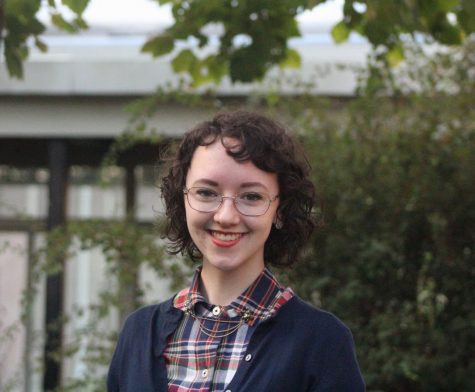
Committed to graduate in 2020, Laura Madler is Editor-in-Chief and fourth year staff writer for the Lion's Roar. Outside of class, she can be found twirling...
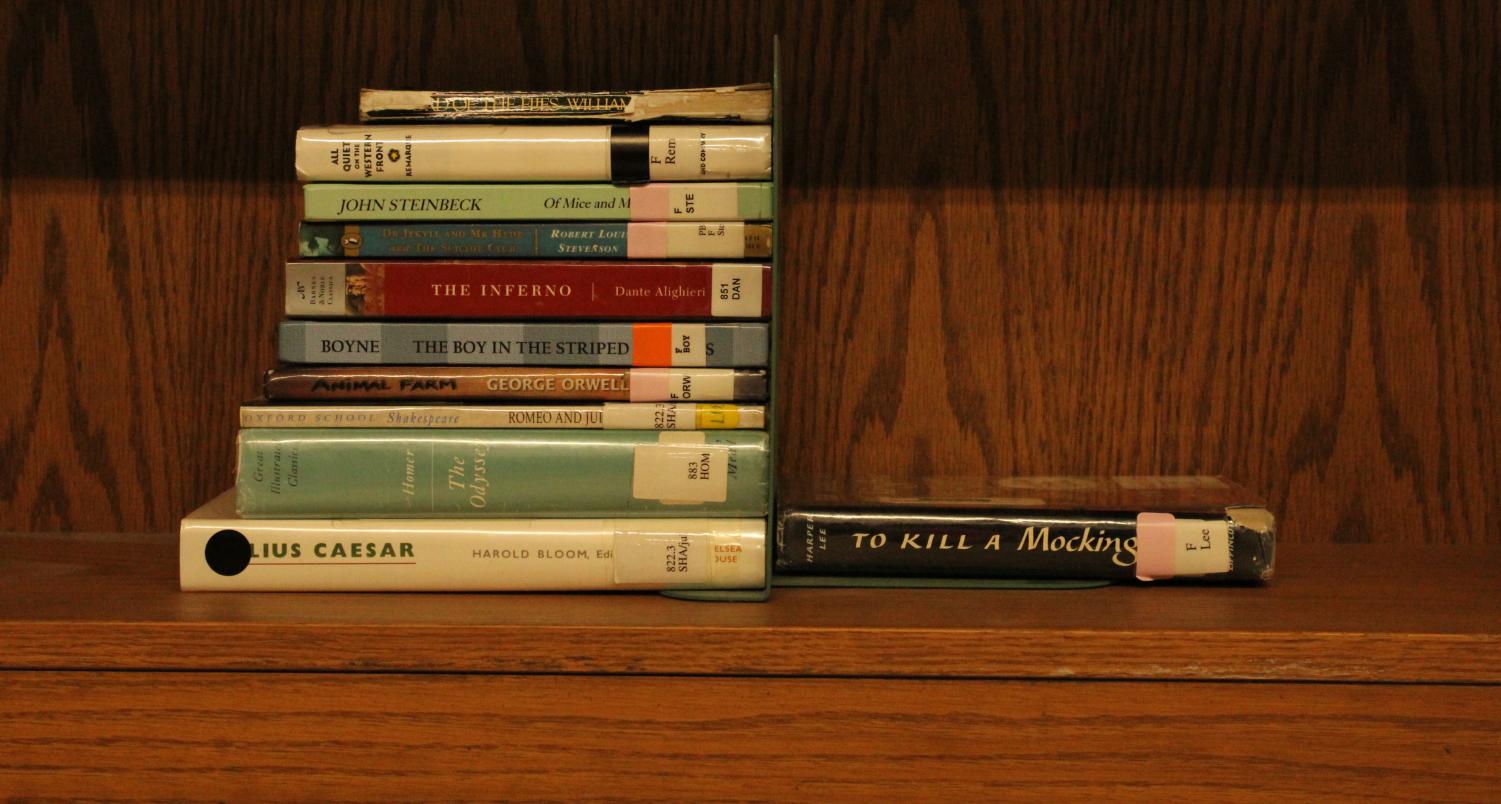

Examining the lack of female representation in Menchville's underclassmen English curriculum
June 6, 2018
Menchville’s English literature classes teach the “classics”- the hallmarks of English literature. Generations of students read the same old books, written by the same old (and likely dead) authors, studying the same old themes and meanings. For years these books haven’t budged from their spots in curriculums, and for years these books have been lacking in the same area- female representation.
In 1990, educator and English curriculum author Arthur N. Applebee published a survey of nationwide high school English curriculums with the Center for Learning and Teaching Literature. Results from national schools displayed similar, and strongly male-centered, curriculums. Part of the Applebee survey examined reports from public schools across the country on what major works they had classes read in English (excluding poetry and short stories). The top 10 books taught in public schools: Romeo and Juliet; Macbeth; Huckleberry Finn; Julius Caesar; To Kill a Mockingbird; The Scarlett Letter; Of Mice and Men; Hamlet; The Great Gatsby; Lord of the Flies. These top ten books were almost exactly the same as the top 10 books taught in the 1960s- when the survey was issued for the first time. Of these ten, only two books feature female main characters, and only one female author is represented. Said the report, “The lists of most frequently required texts show little recognition of the works of women or of minority authors. In all settings examined, the lists of most frequently required books and authors were dominated by white males, with little change in overall balance from similar lists 25 years ago.”
As the 1990 study suggests, books found on high school curriculums rarely contain strong female main characters, and perhaps even more rarely contain female authors. Class time is devoted to Americana novels and stories about flawed and triumphant men. Few of the reported “top 10” books studied use women as anything more than a side character, or worse, a sexual object causing man’s downfall. These books are classic and deserving of acclaim, no doubt, but English curriculums, like that of the 9th and 10th grade at Menchville, full of male-centered classic novels fall short of female representation by any modern standards.
One of the most prevalent ways of judging female representation in media today is the Bechdel- Wallace Test. The Bechdel-Wallace Test is a 3-requirement test commonly used today to test female representation initially in film, but also in other artistic and media works. Alison Bechdel and Liz Wallace first introduced the test in Bechdel’s comic strip in 1985 to illustrate the limited use of women in film, and in years since it has become a serious standard by which entertainment material can be examined. The test stipulates that a work must have: (1.) Two named female characters (2.) who talk to each other (3.) about something other than a man- as said in “The Rule,” a 1985 strip by Bechdel.
In theory, it should not be hard for an entertainment work to pass the test, yet much of film and literature falls short. Application of this test to a school setting, specifically Menchville’s 9th and 10th grade English literature curriculum, yields particularly dismal results.
Excluding autobiographies, short stories, and poetry, students in Menchville’s 9th and 10th grade English classes read a max of thirteen works of fictional literature- books that have commonly come to be known in culture as “classics”. Of these thirteen, only two pass the full Bechdel-Wallace Test for female representation- To Kill a Mockingbird and Antigone– equating to 15.4% of the 9th and 10th grade curriculum. The strongest female character students will read about is Scout in To Kill a Mockingbird, but even she is pushed aside to serve as narrator in the second half of the book, which focuses on her father. Most of the books in the two years of curriculum have very few women, who typically serve as expendable side characters or plot devices used to start conflict, like Steinbeck’s one female character in Of Mice in Men, who is given no name and referred to only in demeaning terms or as property of her husband.
The student curriculum is also lacking in representation of female authors. Over two years, Menchville 9th and 10th graders will read one book by a female author- Harper Lee’s To Kill a Mockingbird. In contrast, the curriculum includes three times as many books by men named “William” and twice as many by men named “John”.
Why then, with such a collection of remarkable female literature written in the late 19th – 21st centuries, do schools continue to avoid teaching female-authored and focused books?
“There has historically been a recognized canon that people call classic literature, and for the most part, up until the last forty years, it has been almost exclusively what we call ‘dead white males’. I don’t know if that’s my definition of classic literature. Classic literature to me is more literature that is intellectually challenging and speaks to universal human conditions,” said 11th grade English teacher Jennifer Wenska. “I think the schools are very much stuck in a sort of 1950s mindset about what classic literature is.”
In fact, the classic literature curriculum for high school students has barely changed since Menchville’s high school teachers themselves were students. Both Wenska and 9th grade English teacher Ryan Bull can recall reading the same material when they were in high school that both now teach to their own students.
Having an old curriculum like this can make it difficult for the literary lessons to apply to modern students and a modern mindset- one of the complaints of Menchville students who responded to our own survey on the English curriculum- particularly in the ways this literature portrays women.
Bull remarked on the characters in the curriculum, “I’d like to see strong female characters in literature; I think that’s more important.” He continued, “I’m not concerned with who the author is, I’m concerned with the quality of the story, and I do think there are certain qualities that are underrepresented in the literature we teach.”
In addition to negative portrayals of female characters, the 9th and 10th grade curriculum includes only one female author, which contributes to the curriculum’s poor female representation.
“I think that it’s a crucial thing [including female authors] that middle and high school English departments should be doing, because the female experience makes up half of the world experience. In 9th and 10th grade, they are pretty abysmal in terms of female authors,” said Wenska.
Women make up half the population of the world, but the female experience is often taught in literature through the eyes of men. This is not to say that no strong female characters have come from male-authored literature, but sometimes the female experience is best told through the eyes of a woman. The Newport News curriculum does not include any of this sort of literature in a curriculum that is taught to classes that will be, statistically, close to 50% female.
What makes a character “well-written” is up for debate, but it can be seen that male and female authors craft their female characters in noticeably different ways. Female characters written by women tend to forego many of the common traditional stereotypes of what the female character should be- usually a temptress, a damsel in distress, or an unwanted shrew. These female-authored characters tend to be more flawed and not so one-dimensional as their male-written counterparts. They stray further from stereotypes and allow for dynamic character development through the story. Female authors are typically more willing to embrace the whole of a woman’s character, not just focus on the way she looks or how perfect she is.
12 AP English teacher Susan Trander lamented, “I think there is a difference [between male and female written women characters]; I think a lot of times men create characters that are strong and beautiful– physically. I actually can’t think of characters that are plain or not that physically interesting.” She continued, “I think female writers are much more apt to offer characters that are not that distinguishable physically. They’re also just going to be more real- I think that they are braver because they understand that females in general, we all battle similar things but sometimes different and we have different personalities and likes, and I think women are more apt to mix these and make more realistic characters.”
This lack of female authorship in high school curriculum could be attributed to a number of factors. Menchville students, when surveyed about the lack of female authors in the English curriculum, pointed out that “women weren’t writing and publishing during the era of classic literature”. Others said that the imbalance could be due to male-authored novels being historically more publicized and studied more often. What has kept female authors largely out of high school classrooms today, however, can in some cases be linked to a form of mild censorship, in which adults intend to shield students from topics deemed too mature for the audience.
Books read and studied in school classrooms must naturally be deemed appropriate for the age group and school setting. This makes it difficult for classes to study literature concerning mature topics, such as abuse, rape, and discrimination. The manner in which these issues are addressed and depicted can differ from author to author, but generally the depictions tend to be more graphic and more realistic when told from the minority point of view. Because of this, female-authored books can be problematic for school curriculums, particularly when parents and adults may want to keep their children from in-depth study of some harsher, more unsettling features of the female experience.
“I think a lot of female-centered, more contemporary literature depicts sexual violence and abuse more, and those are topics that make people uncomfortable, and I think that’s part of the reason why they are oftentimes banned. Generally, books that, whether written by males or females, point out how a dominant group has oppressed or marginalized people like women and minorities- those are the books that get banned and criticized and people don’t want their kids reading it,” said Traner.
Wenska addressed possible bias within censorship itself, saying that realistic accounts of dangers that women face, like sexual abuse, are more likely to be rejected by the administrators in charge of curriculum than firsthand accounts of other difficult situations. “One of the controversial books that we have in our bookroom right now, which nobody ever teaches, is Speak by Laurie Halse Anderson. It’s the story of a girl who’s raped as a teenager and it’s pretty graphic, it’s pretty out there, and nobody teaches it. Definitely some of the depictions of women’s lives and the things that happen in women’s lives are a little too rough for most high school teachers to want to confront, but on the other hand they will confront the horrors of African American life or the horrors of the Holocaust. I think there is some unspoken bias there.”
Appropriate material is a fickle thing to work with in school settings. There are certainly books and themes that could be considered too mature for a high school classroom, but there are also many female-authored books that have been fought over on questionable claims. Traner cited reviewers’ criticisms of Angie Thomas’s The Hate U Give for “excessive vulgarity,” saying that “I think it’s really because it’s so timely and it’s about controversial subjects and they won’t say that- they say it’s because there’s so much cussing in the book.”
She continued, “I think that there are certain well-meaning people who feel that students of whatever level cannot handle those kinds of subjects, and sometimes it’s because they want to shelter their kids from the horrors of life. In my experience with students for 20 years, kids are a lot more resilient and more knowledgeable, generally more apt to self-censor, and I think that’s wonderful. But when adults get involved and try to mandate what kids or should or should not read, it oftentimes backfires because then, as soon as kids know ‘oh I’m not supposed to read this,’ that’s when it becomes more attractive for students to read. I think that they handle it [censorable material] better than people think, and now there’s so much media out there with Youtube, violent movies, and graphic TV that there’s a lot of exposure that’s harder to endure than in a book.”
Granted, the books on Menchville’s English curriculum are well-written works of literature that have been impactful on the world. Each one has merit and worth making it deserving of a spot in class study. Unfortunately, many of these books tell stories from the same points of view featuring the same sorts of male characters. The curriculum has attempted to remedy this gender imbalance by including some female works in “short story” units from the class textbooks, but the major literary works remain dominated by the same male authors that have been read in high school for over 50 years.
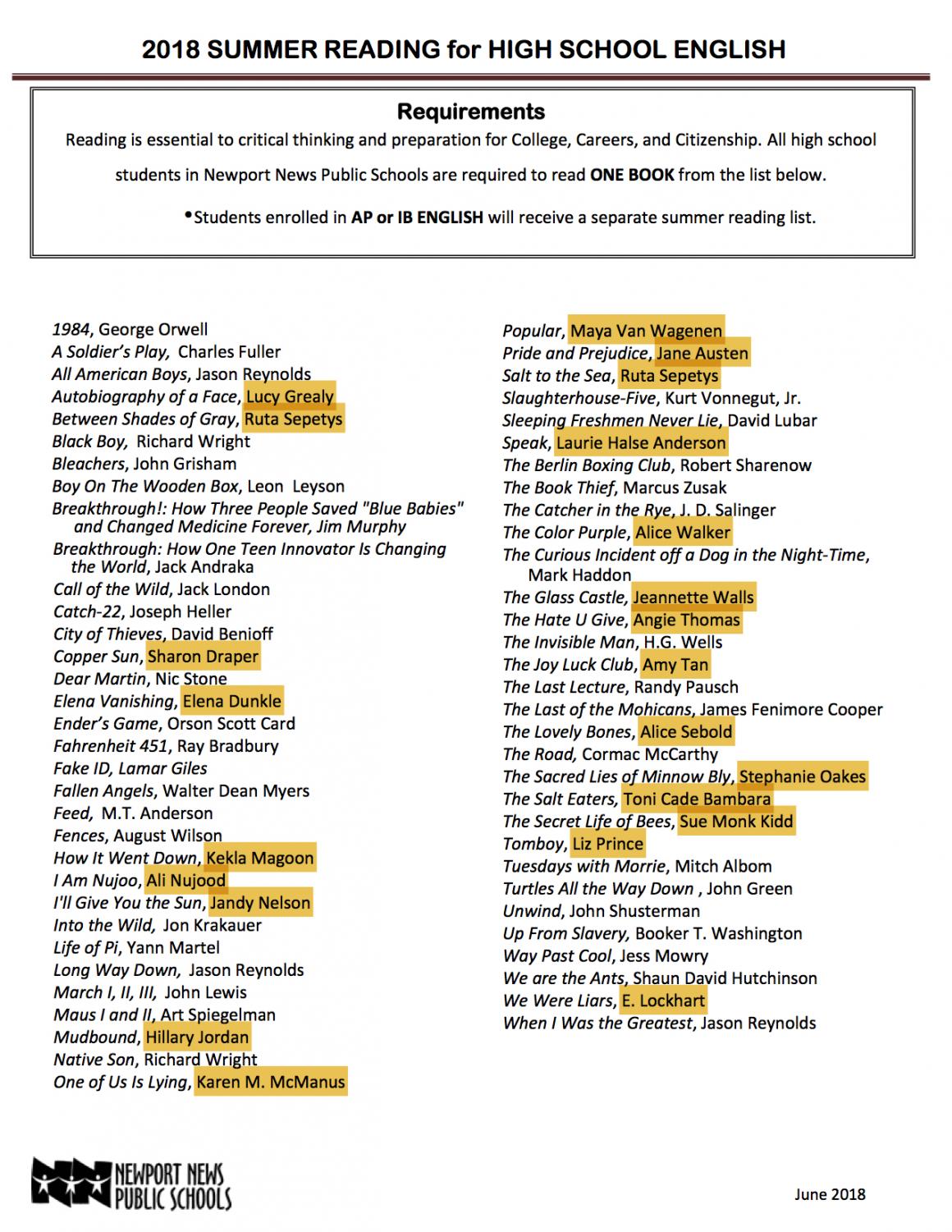
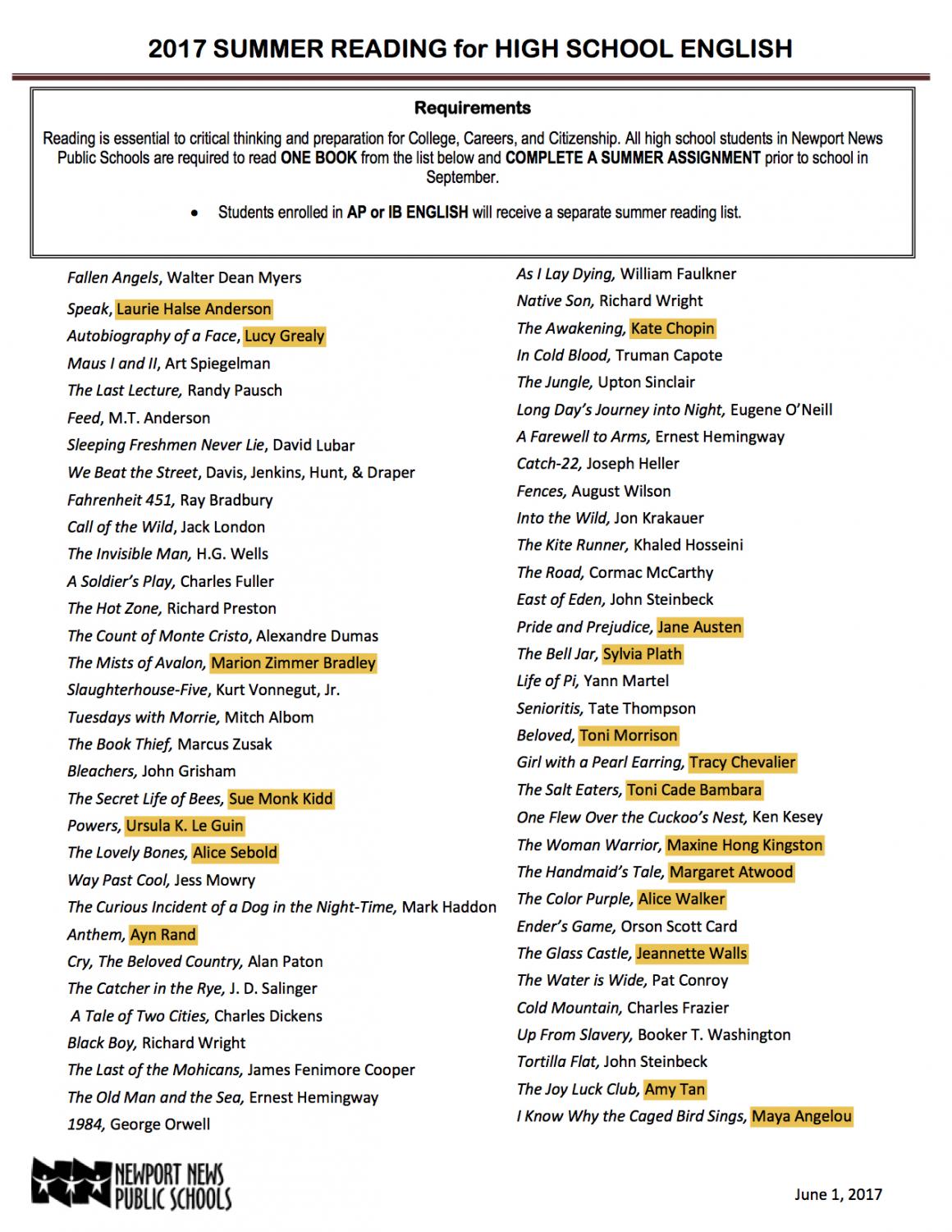
The summer reading list includes a much more diverse array of stories and authors, with 35.9% of authors female, and many of the stories modern and written from minority points of view. However, many students may not read the extra material over the summer, which means that some may only experience the literature presented to them in class- not always to great effect.
“I’ve always loved reading and found great enjoyment in the activity. This year, I can say [the curriculum has] dramatically discouraged me from reading [similar material].” said freshman Sophia Ottofaro.
When asked to give the title of the last book they read, only 25.9% of surveyed Menchville students reported having recently read a book not required for class.
Freshman Joelle Kurten commented, “We usually always read books and stories that are thought of as classics and have nothing to do with us. We can’t relate to literature written a long time ago.” “I feel that we should have more books with strong female leads and books we can seriously relate to.”
One question on the survey given to several Menchville English classes asked the students to estimate what percentage of the curriculum’s reading material featured strong female characters. Female students strongly felt that the reading material featured a male majority, while results from male students were spread out more across the percentage range. Another question on the survey asked students whether there should be more female authors represented in the required reading material on the English curriculum. Most students surveyed agreed that there should be more representation of female-written books in the English curriculum.
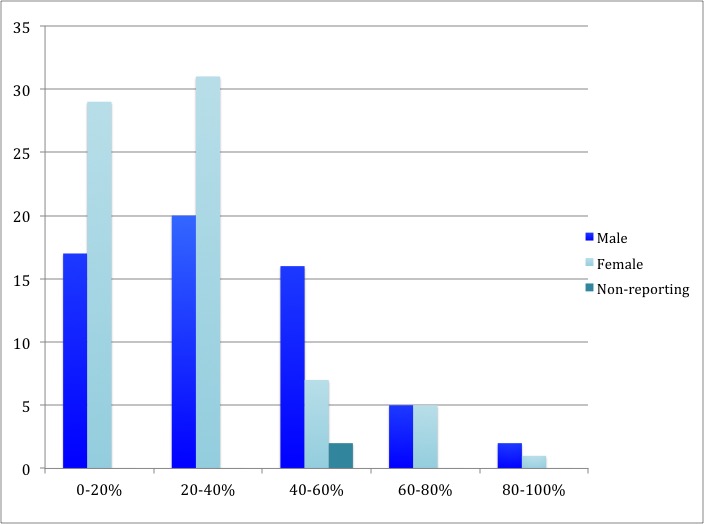
The world is 50% female, but even in the 21st century it feels like Menchville, and most public schools across the nation, are not providing an opportunity for the female literary voice to be heard.

Committed to graduate in 2020, Laura Madler is Editor-in-Chief and fourth year staff writer for the Lion's Roar. Outside of class, she can be found twirling...